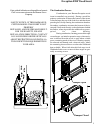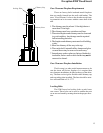
Exception F200 Wood Insert
7
cause a fire. Overfiring is caused by:
1. Too much air flowing through the insert too
quickly.
2. You may have positioned the primary air control
level too far to the left.
3. Inadvertently left the damper open or
4. Not kept up with routine maintenance, such as
checking door gaskets for wear.
Overfiring results in excessive fuel consumption, and
may cause parts of the insert to glow red. If you notice
signs of overfiring, reduce the air supply to the fire, and
review the Maintenance section in this manual.
Never leave the insert unattended with the
door open. Overfiring may result.
In the event of a chimney fire, call your local fire
department; make sure everyone is safely out of the house.
Reduce the air intake of the insert as much as possible
using the air control lever; close the bypass damper to
further restrict air flow. Do not throw water on the fire;
this can cause insert damage and create an even more
dangerous situation. Have your chimney professionally
cleaned and inspected before resuming burning in your
insert.
Removing and Disposing of Ashes.
Before opening the door to remove the ashes, open
the bypass damper. Wearing heavy protective gloves,
remove ashes from the fire chamber periodically with a
small shovel. Close the door before taking the ashes out-
side for safe disposal.
A good time to empty the ashes is before loading.
This ensures that the ashes will be cold and safer to handle
than directly after poking the ashes down or tending the
fire.
Never let the ashes build up to over 2" in depth.
Excessive ash buildup can prevent proper venting of ex-
haust gases.
Ashes should be placed in a metal container with a
tight fitting lid. The closed container of ashes should be
placed on a noncombustible floor or on the ground, well
away from all combustible materials, pending final dis-
posal. If the ashes are disposed of by burial in soil or
otherwise locally dispersed, they should be retained in the
closed container until all cinders have thoroughly cooled.
Never use the ash disposal container for other trash.
Wood ash can be added to your garden or compost.
When the air setting is low, the blower should
always be at the minimum setting (corresponding to a
blower speed of 750 RPM.) At higher settings above
first notch the blower may be set to your desired comfort
level. Be sure that the blower cord does not run under,
over, above or in front of the insert.
The following guidelines for air settings can be
used for wood burning; as you become familiar with your
insert, you will know which settings best heat your home.
Minimum Burn Rate - air control fully to right.
Medium Low Burn Rate - air control pulled 1"
out to the second notch.
Medium High Burn Rate - air control puled out to
the fourth notch. This setting may be used to burn
wood that is damp in order to keep it burning, but
will consume seasoned, dry wood too fast.
High Burn Rate - air control fully pulled out. This
setting is for refueling and starting a fire. Continuous
burning at this setting will cause premature failure of
consumable parts such as the afterburner hood and
firebricks.
Note: At minimum burn rates the glass may get dirty
but will clean off again at higher burn rates.
After Burner Viewport.
This is a small ceramic glass window in the back
of the firebox. This window allows you to see the After-
burner Combustion System in action. This glass may
smoke up under some conditions but will burn off again.
It is OK if this glass is not totally clean.
Operating as a Fireplace.
The F200 is tested and approved to be burned with
the front load door open and the damper open. In this
mode of operation you get a true fire sound as well as
appearance. Due to the crackling and popping of burning
wood it is necessary to place the optional screen over the
door opening. This prevents sparks from entering the room
just like a screen over a fireplace.
The insert is hot while in operation. Keep
children, clothing and furniture away.
Contact may cause skin burns.
Overfiring
Avoid overfiring your insert, a potentially hazard-
ous situation which can lead to overheating of combus-
tible materials, damage to the insert, and in extreme cases,
Curing Paint.
As you begin to operate your insert at higher
temperatures, you will notice a “hot” or unpleasant
smell; this is just the paint going through the cur-
ing process, and will disappear after a few fires.
Evaluation notes were added to the output document. To get rid of these notes, please order your copy of ePrint IV now.


















